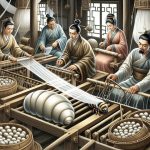Do you want to know what silk net fabric is? Well, you’re in luck! In this article, we’ll dive into the history, characteristics, production process, and various types of silk net fabric.
You’ll also discover the many uses and applications of this versatile material. Plus, we’ll provide you with some handy care and maintenance tips to keep your silk net fabric looking fabulous.
So, let’s get started and learn all about this fascinating fabric!
Table of Contents
History of Silk Net Fabric
If you’re curious about the history of silk net fabric, let me tell you that it dates back to ancient China. The evolution of silk net fabric can be traced back to the Han Dynasty, which ruled China from 206 BCE to 220 CE.
During this time, silk production was highly developed, and silk net fabric became popular due to its unique properties. Silk net fabric was initially used for fishing nets, but its versatility soon led to its use in various aspects of daily life.
The cultural significance of silk net fabric in ancient China cannot be overstated. It was not only a functional material but also a symbol of wealth and status. Silk net fabric was often associated with the elite and the ruling class. It was used to make luxurious clothing, accessories, and even decorative elements in architecture. Silk net fabric was also a prized trade commodity, exported to other regions and countries along the Silk Road.
Characteristics and Properties of Silk Net Fabric
One of the characteristics of silk net fabric is that it is lightweight and breathable. Silk net fabric is known for its delicate and sheer appearance, making it a popular choice for wedding gowns, lingerie, and other elegant garments. The lightweight nature of silk net fabric allows for comfortable wear, as it drapes effortlessly over the body. Its breathable properties allow air to circulate, preventing the fabric from trapping heat and moisture, making it suitable for warm weather or active wear.
In addition to being lightweight and breathable, silk net fabric also has a smooth and soft texture. The silk fibers used in its construction give it a luxurious feel, making it a favorite among designers and fashion enthusiasts. Despite its delicate appearance, silk net fabric is surprisingly durable, thanks to the strength of the silk fibers. This makes it a versatile fabric that can withstand daily wear and tear.
Silk net fabric is also known for its ability to drape beautifully. Its fine threads create a flowing and ethereal effect, making it ideal for creating stunning drapes, ruffles, and gathers. Its natural sheen adds a touch of elegance to any garment, making it a popular choice for formal and evening wear.
Overall, the characteristics and properties of silk net fabric make it a versatile and luxurious fabric choice for creating stunning and breathable garments.
Production Process of Silk Net Fabric
In this discussion, you’ll learn about:
- The various techniques used in weaving silk net fabric
- The methods of dyeing silk net
- The factors that can impact the quality of the fabric
These key points will provide you with a comprehensive understanding of the production process of silk net fabric.
Silk Net Weaving Techniques
To achieve intricate patterns in silk net fabric, you can try using different weaving techniques.
Silk net embroidery techniques are widely used in the fashion industry to create stunning designs and textures.
One popular technique is the plain weave, which involves passing the weft thread over and under the warp threads in an alternating pattern. This creates a simple yet elegant net-like structure.
Another technique is the leno weave, where warp threads are twisted around each other to create small openings in the fabric. This adds a delicate and airy quality to the silk net.
Lastly, the brocade weave is often used for more elaborate designs, incorporating metallic threads or additional yarns to create intricate patterns.
These weaving techniques allow designers to create unique and beautiful silk net fabrics that are highly coveted in the fashion industry.
Silk Net Dyeing Methods
Try experimenting with various dyeing methods to add vibrant colors to your silk net creations. Silk net fabric dyeing techniques offer endless possibilities for customization.
Here are some advantages of silk net fabric:
- Breathability: Silk net allows air to circulate, making it comfortable to wear in warm weather.
- Sheerness: The delicate, transparent nature of silk net adds a touch of elegance to any garment.
- Durability: Despite its delicate appearance, silk net is surprisingly strong and long-lasting.
To dye your silk net fabric, you can try techniques such as dip dyeing, tie-dyeing, or using fabric paints. Each method will create unique and eye-catching results. Remember to follow the specific dyeing instructions for silk net fabric to ensure the best outcome.
With a little experimentation, you can transform your silk net creations into stunning and vibrant pieces.
Factors Affecting Fabric Quality
Now let’s discuss the factors that can affect the quality of fabric, specifically the impact of sustainability and the role of technology in improving it.
When it comes to sustainability, fabric quality is greatly influenced by the use of eco-friendly materials and production methods. By opting for sustainable practices, such as using organic fibers and reducing water and chemical usage, the overall quality of the fabric can be enhanced.
Additionally, technology plays a crucial role in improving fabric quality. Advanced machinery and processes allow for better control over production variables, resulting in consistent and high-quality fabrics. From automated weaving machines to digital printing techniques, technology has revolutionized the textile industry and continues to drive improvements in fabric quality.
Different Types and Variations of Silk Net Fabric
When it comes to silk net fabric, there are various types and variations that you can explore.
From delicate and intricate lace-like designs to more structured and sturdy netting, the options are endless.
Whether you’re looking for a fabric that adds a touch of elegance to your outfit or one that provides breathability and comfort, silk net has something to offer for every occasion.
Silk Net Fabric Variations
Silk net fabric comes in various variations, including different colors and patterns. It is a versatile fabric that can be used for a variety of purposes, from clothing to home decor.
When it comes to silk net fabric designs, there are endless options to choose from. Some popular designs include floral patterns, geometric shapes, and intricate lace-like motifs. These designs add elegance and sophistication to any garment or project.
Silk net fabric is especially popular in bridal wear, as it adds a delicate and ethereal touch to wedding dresses and veils. Brides often choose silk net fabric for its lightweight and sheer quality, creating a romantic and dreamy look.
Whether you’re looking for a vibrant color or a subtle pattern, silk net fabric offers a wide range of options to suit your style and needs.
Types of Silk Net
If you’re looking for variety, there are different types of silk net available for you to choose from.
Silk net fabric is a popular choice in fashion, especially for its delicate and sheer appearance. It adds a touch of elegance and femininity to any garment.
Whether you’re going for a classic or modern look, silk net can be styled in various ways to suit your fashion taste. From intricate lace patterns to bold prints, there is a wide range of designs available in silk net.
Not only is silk net fashionable, but it is also sustainable. Silk production is known for its eco-friendly practices, making it an environmentally conscious choice for fashion enthusiasts.
Exploring Silk Net
There’s a wide range of designs available, so you can easily find a style of silk net that suits your fashion taste. Silk net fabric is not only popular in the fashion industry but also in home decor.
Here are a few ways silk net can be incorporated into your fashion and home decor:
-
Fashion: Silk net is commonly used in creating delicate and airy garments such as dresses, blouses, and scarves. Its sheer nature adds a touch of elegance and femininity to any outfit.
-
Home Decor: Silk net curtains can create a soft and romantic ambiance in your living space. Additionally, silk net can be used as a decorative fabric for pillows, table runners, or even as a canopy for your bed, adding a luxurious and ethereal touch to your home.
With its versatility and timeless appeal, silk net fabric continues to be a popular choice in both fashion and home decor.
Uses and Applications of Silk Net Fabric
The versatility of silk net fabric makes it a popular choice for creating delicate and breathable garments. Fashion trends have embraced the use of silk net fabric in various ways. Designers have incorporated it into dresses, blouses, and skirts to add a touch of elegance and femininity. The sheer nature of the fabric allows for a sensual and lightweight feel, perfect for summer outfits or evening wear.
In addition to fashion, silk net fabric also has advantages in home decor. Its transparency adds a touch of sophistication when used as curtains or drapes, allowing natural light to filter through while still maintaining privacy. The delicate and airy nature of the fabric also makes it a popular choice for creating decorative accents such as throw pillows or table runners.
The breathable quality of silk net fabric is another advantage that makes it suitable for both clothing and home decor. It allows air to circulate, keeping you cool and comfortable in hot weather. Its lightweight nature also makes it easy to drape and move, giving a flowing and ethereal look to any garment or room.
Overall, the versatility, breathability, and delicate nature of silk net fabric make it a desirable choice for both fashion and home decor applications.
Care and Maintenance Tips for Silk Net Fabric
Now that you know about the various uses and applications of silk net fabric, let’s talk about how to take care of and maintain this delicate fabric.
When it comes to silk net fabric care, it’s important to handle it with care and gentleness. Here are some tips to help you keep your silk net fabric looking its best:
-
Handwashing: Always handwash silk net fabric using a gentle detergent and lukewarm water. Avoid using harsh chemicals or bleach, as they can damage the delicate fibers.
-
Drying: After washing, gently squeeze out excess water and lay the fabric flat on a clean towel to air dry. Avoid wringing or twisting the fabric, as it can cause wrinkles or stretching.
-
Storage: When storing silk net fabric, make sure it is clean and dry. Fold it carefully and store it in a cool, dry place away from direct sunlight to prevent fading or discoloration.
Conclusion
Overall, silk net fabric is a versatile and delicate material that has a rich history and unique characteristics. It is produced through a meticulous process and comes in various types and variations.
Silk net fabric can be used for a wide range of applications, from clothing to home decor. To ensure its longevity, proper care and maintenance should be practiced.
With its elegant appearance and luxurious feel, silk net fabric continues to be a popular choice for those looking for a touch of sophistication in their garments and surroundings.
- How Does Ring Spun Cotton Affect Garment Fit and Shape Retention? - August 13, 2024
- What Are the Challenges in Producing Ring Spun Cotton? - August 13, 2024
- Is Ring Spun Cotton Suitable for Plus-Size Clothing? - August 13, 2024



